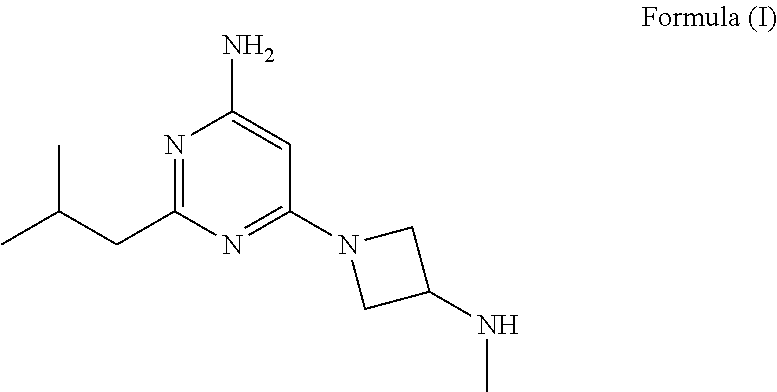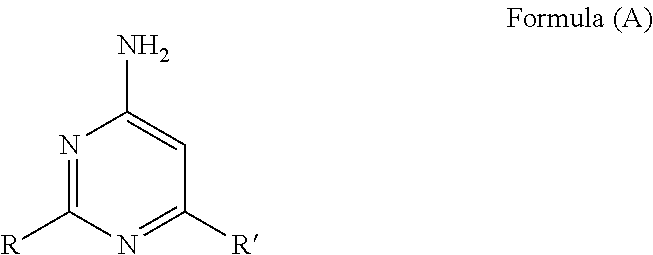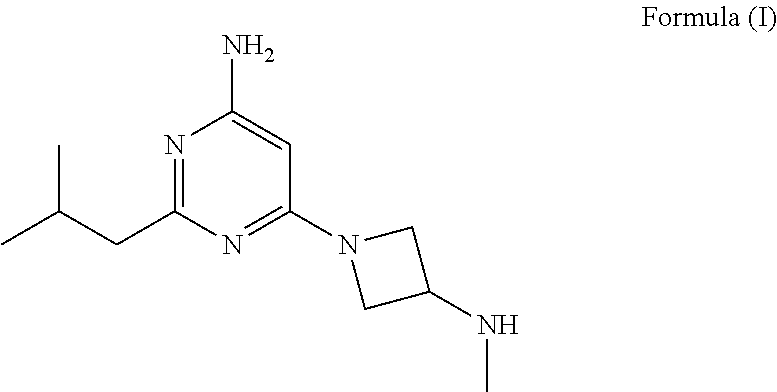Synthesis of 4-aminopyrimidine compounds
a technology of pyrimidine and pyrimidine, which is applied in the field of synthesis of 4aminopyrimidine compounds and the synthesis of 2isobutyl6(3(methylamino) azetidin1yl) pyrimidin4amine, can solve the problems of low yield, high operation cost of prior art manufacturing processes, and limit industrial synthesis of compounds
- Summary
- Abstract
- Description
- Claims
- Application Information
AI Technical Summary
Benefits of technology
Problems solved by technology
Method used
Image
Examples
example 1
of Compound (V) [6-amino-2-isobutylpyrimidin-4-ol]
[0189]Reaction: 3-Methylbutanimidamide acetate [Compound (VI)] (20.0 g; 125 mmol; 1.0 eq) was suspended in EtOH (40 ml; 2 rel vols). NaOEt 21wt-% (60.7 g; 187 mmol; 1.5 eq.) was charged and heated to 70° C. A solution of ethyl 2-cyanoacetate [Compound (VII)] (16.2 g; 144 mmol; 1.15 eq.) in EtOH (20 ml; 2 vols) is dosed slowly (about 4 hours). Conversion was checked by GC after 40% addition [Compound (V) 45%] and 100% addition [Compound (V) 69%]. Conversion was checked by GC after reaction for 21 hours at 70° C. [85% Compound (V)]. The mixture was stirred overnight at 70° C.
[0190]Work-up and isolation: Mixture was cooled to 50° C. then quenched with AcOH (0.55 eq.; 4.13 g). Water (8 vols) was charged. Mixture is concentrated at 50-55° C. to about 7 vols. Suspension stripped with ACN (3 vols) to a final volume of about 6 vols, then cooled to 0-5° C. Mixture was further diluted with water (2 vols) and stirred for 2 hours. Solids were fi...
example 2
of Compound (III) [6-chloro-2-isobutylpyrimidin-4-amine]
[0192]Reaction: 6-amino-2-isobutylpyrimidin-4-ol [Compound (V)] (30.0 g; 179 mmol; 1.0 eq) from Example 1 was suspended in ACN (150 ml; 5 vols) at room temperature (RT). POCl3 (138 g; 897 mmol; 5.0 eq.) was charged. The suspension was heated step wise to 60° C., 65° C. then 70° C. and stirred at 70° C. for 15 minutes. The suspension was further heated to 80° C. and stirred overnight. Conversion was checked with HPLC after 19 hours at 80° C. ([Compound (III)] 98.9%).
[0193]Work-up: The mixture was concentrated at 60-70° C. to about 3 rel vols. The mixture was stripped 3 times with toluene (3 vols) at 60-70° C., diluted with toluene (2 vols) then temperature was adjusted to ±50° C. The mixture was quenched with water (5 vols). Temperature was adjusted to 60° C. and the mixture was stirred for at least 30 minutes at 55-65° C. Phase separation: AL was isolated and transferred back to the reactor and diluted with water (1 vol). Tempe...
example 3
of Compound (II') [tert-butyl (1-(6-amino-2-isobutylpyrimidin-4-yl)azetidin-3-yl)(methyl)carbamate]
[0196]Reaction: 6-chloro-2-isobutylpyrimidin-4-amine [Compound (III)] (25.0 g; 135 mmol; 1.0 eq) from Example 2 and K2CO3 (22.3 g; 162 mmol; 1.2 eq.) were charged to the reactor. Tert-butyl azetidin-3-yl(methyl)carbamate [Compound (IV′)] (26.1 g, 140 mmol, 1.04 eq.) dissolved in DMSO (msolution=148 g, 17.6 wt-%) was charged and the mixture was heated to 110° C. Conversion was measured after 24 hours (Compound (II') 93%).
[0197]Work-up and isolation: The mixture was cooled to 50-60° C. then was diluted with water (6 vol) and EtOAc (10 vol) and stirred for 5 min. Phase separation: the OL was isolated then washed with water (2 vol). The OL was concentrated to about 6 rel. vols. at 65-75° C. The solution was stripped 3 times with iPAc (4 vol). The solution was cooled slowly to RT. The suspension was cooled further to 0-5° C. After 30 min of stirring, the solids were filtered off, washed twi...
PUM
 Login to View More
Login to View More Abstract
Description
Claims
Application Information
 Login to View More
Login to View More - R&D
- Intellectual Property
- Life Sciences
- Materials
- Tech Scout
- Unparalleled Data Quality
- Higher Quality Content
- 60% Fewer Hallucinations
Browse by: Latest US Patents, China's latest patents, Technical Efficacy Thesaurus, Application Domain, Technology Topic, Popular Technical Reports.
© 2025 PatSnap. All rights reserved.Legal|Privacy policy|Modern Slavery Act Transparency Statement|Sitemap|About US| Contact US: help@patsnap.com



